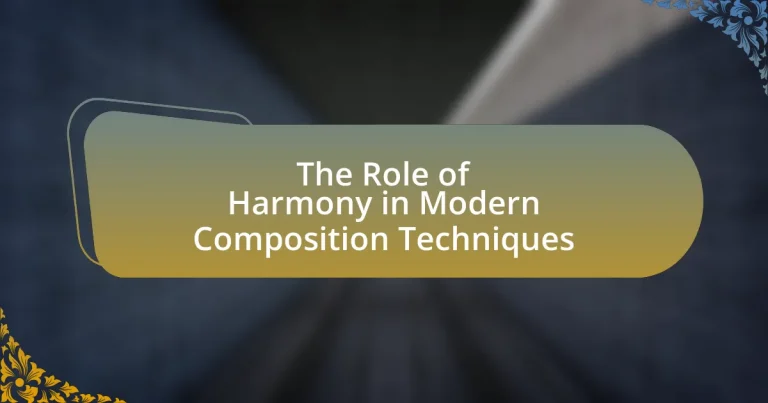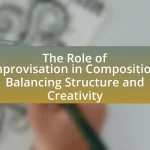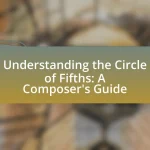The article examines the critical role of harmony in modern composition techniques, highlighting its foundational importance in supporting melody and rhythm. It explores the evolution of harmony from traditional tonal structures to contemporary practices, including atonality and modal interchange, while discussing historical influences and genre-specific approaches. Key elements such as chord structures, dissonance, and consonance are analyzed, along with the emotional effects of harmony on listeners. The article also addresses the integration of technology in shaping harmonic choices and offers practical tips for composers to enhance their work through innovative harmonic techniques.
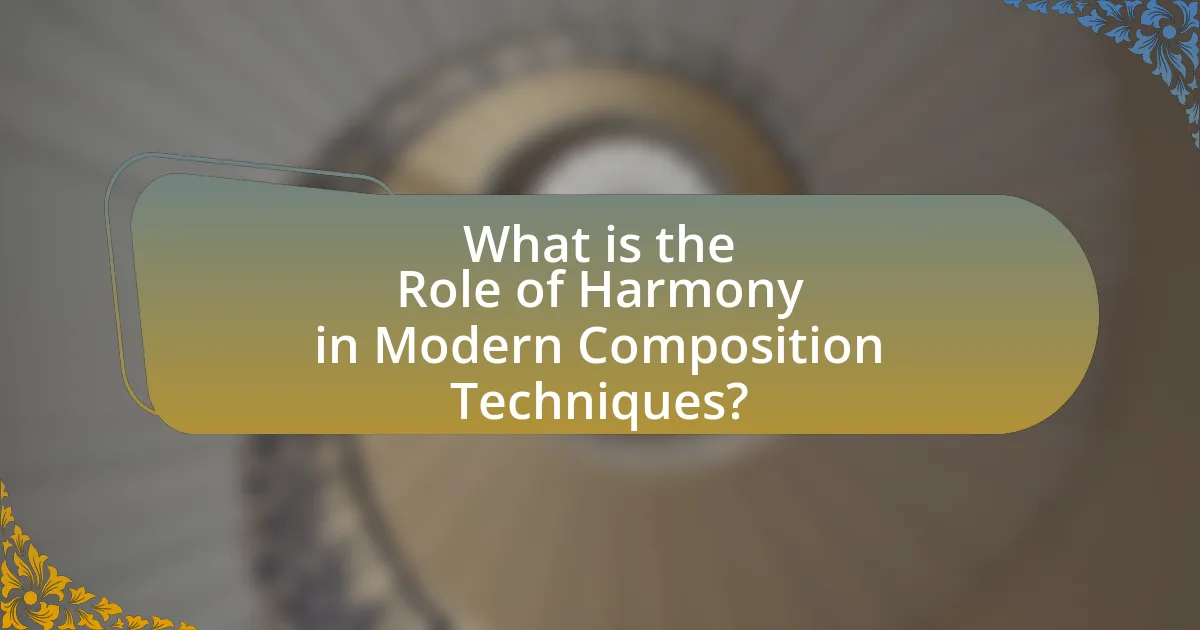
What is the Role of Harmony in Modern Composition Techniques?
Harmony plays a crucial role in modern composition techniques by providing the foundational structure that supports melody and rhythm. In contemporary music, harmony is often used to create emotional depth and complexity, allowing composers to explore diverse musical landscapes. For instance, the use of extended chords and unconventional harmonic progressions can evoke specific feelings and atmospheres, as seen in the works of composers like Steve Reich and Philip Glass, who utilize harmony to enhance their minimalist styles. Additionally, harmony in modern composition often incorporates elements from various genres, such as jazz and electronic music, which further expands its expressive capabilities. This adaptability demonstrates harmony’s significance in shaping the overall character and impact of modern musical works.
How has the concept of harmony evolved in contemporary music?
The concept of harmony in contemporary music has evolved from traditional tonal structures to more complex and varied approaches, including atonality, microtonality, and modal interchange. This shift reflects a broader exploration of sound and emotional expression, as seen in genres like jazz, electronic, and avant-garde music. For instance, jazz musicians often utilize extended chords and altered scales, while electronic music frequently incorporates non-traditional harmonic frameworks, allowing for innovative soundscapes. The incorporation of diverse cultural influences and technological advancements has further expanded harmonic possibilities, leading to a richer and more dynamic musical landscape.
What historical influences have shaped modern harmony?
The historical influences that have shaped modern harmony include the development of tonal systems during the Renaissance, the expansion of harmonic language in the Baroque period, and the innovations of Romantic composers. The Renaissance introduced the use of triads and counterpoint, establishing a foundation for harmonic structure. The Baroque era saw the emergence of figured bass and the establishment of major-minor tonality, which expanded harmonic possibilities. Romantic composers further pushed boundaries by incorporating chromaticism and complex chord progressions, leading to the diverse harmonic language present in contemporary music. These historical developments collectively inform the harmonic practices utilized in modern composition techniques.
How do different genres approach harmony in composition?
Different genres approach harmony in composition through distinct frameworks and techniques that reflect their unique stylistic characteristics. For instance, classical music often employs complex harmonic structures, utilizing extended chords and modulations to create tension and resolution, as seen in the works of composers like Beethoven and Mozart. In contrast, jazz emphasizes improvisation and often incorporates altered chords and modal interchange, allowing for greater flexibility and expression, as demonstrated by artists such as Miles Davis and John Coltrane. Popular music typically favors simpler harmonic progressions, often relying on the I-IV-V chords, which create a catchy and accessible sound, exemplified by countless hits across decades. Each genre’s approach to harmony not only defines its sound but also influences the emotional and narrative aspects of the music, showcasing the integral role harmony plays in composition.
Why is harmony considered essential in modern composition?
Harmony is considered essential in modern composition because it provides the foundational structure that supports melody and enhances emotional expression. In contemporary music, harmony allows composers to create complex textures and rich soundscapes, facilitating the exploration of diverse musical styles. For instance, the use of extended chords and unconventional progressions in genres like jazz and film scores demonstrates how harmony can evoke specific moods and atmospheres, thereby enriching the listener’s experience.
What emotional effects does harmony have on listeners?
Harmony evokes a range of emotional effects on listeners, including feelings of joy, calmness, and nostalgia. Research indicates that harmonious sounds can stimulate the release of dopamine, a neurotransmitter associated with pleasure, thereby enhancing positive emotions. For instance, a study published in the journal “Psychological Science” by researchers at the University of California found that consonant harmonies are often perceived as more pleasant and can elicit stronger emotional responses compared to dissonant harmonies. This demonstrates that harmony plays a crucial role in shaping the emotional landscape of musical experiences.
How does harmony contribute to the overall structure of a composition?
Harmony serves as a foundational element in the overall structure of a composition by establishing relationships between different musical notes and chords, which create emotional depth and coherence. This relationship guides the listener’s experience, as harmony influences the tension and resolution within a piece, shaping its narrative arc. For instance, in classical music, the use of harmonic progressions, such as the circle of fifths, provides a sense of direction and structure, allowing composers to build tension that resolves in satisfying ways. Additionally, studies in music theory demonstrate that harmonic structures, like cadences, play a crucial role in delineating sections of a composition, thereby enhancing its overall form and clarity.
What are the key elements of harmony in modern composition?
The key elements of harmony in modern composition include chord structures, dissonance and consonance, harmonic progression, and the use of extended and altered chords. Chord structures form the foundation of harmony, allowing composers to create a sense of stability or tension. Dissonance and consonance are essential for emotional expression, as dissonant chords create tension that resolves into consonant chords, enhancing the musical narrative. Harmonic progression refers to the sequence of chords that establishes the tonal framework of a piece, guiding the listener’s expectations. Additionally, the use of extended and altered chords, such as seventh, ninth, and altered chords, adds complexity and richness to the harmonic palette, allowing for greater emotional depth and innovation in modern compositions. These elements collectively shape the harmonic language of contemporary music, reflecting the evolving nature of musical expression.
What types of chords are commonly used in modern harmony?
Commonly used chords in modern harmony include major, minor, diminished, augmented, seventh, and extended chords. Major and minor chords form the foundation of most contemporary music, providing the basic tonal structure. Diminished and augmented chords introduce tension and complexity, often used in transitions or to create a sense of movement. Seventh chords add depth and richness, frequently appearing in jazz and pop genres. Extended chords, such as ninths, elevenths, and thirteenths, are prevalent in modern compositions, enhancing harmonic texture and color. These chord types are essential for creating the diverse soundscapes found in today’s music.
How do dissonance and consonance play a role in contemporary harmony?
Dissonance and consonance are fundamental elements in contemporary harmony, shaping emotional expression and structural complexity in music. Dissonance introduces tension and conflict, often creating a sense of urgency or unease, while consonance provides resolution and stability, allowing listeners to experience a sense of closure. This interplay is evident in various genres, including jazz and modern classical music, where composers intentionally manipulate these elements to evoke specific feelings or to challenge traditional harmonic expectations. For instance, the use of dissonant chords in jazz can create a rich, layered sound that enhances improvisation, while consonant resolutions can ground the listener amidst the complexity. This dynamic relationship between dissonance and consonance is essential for crafting engaging and innovative musical narratives in contemporary compositions.
How do composers integrate harmony with other musical elements?
Composers integrate harmony with other musical elements by using chord progressions, counterpoint, and rhythmic structures to create cohesive musical narratives. For instance, harmony serves as the foundation upon which melody and rhythm are built, allowing composers to establish emotional context and tension. In classical music, composers like Bach employed counterpoint, where multiple independent melodies interact harmoniously, demonstrating the interplay between harmony and melody. In contemporary genres, artists often blend harmony with rhythm through syncopation and groove, enhancing the overall texture of the music. This integration is evident in jazz, where harmonic improvisation occurs alongside rhythmic variations, showcasing the dynamic relationship between these elements.
What techniques can be used to enhance harmony in compositions?
Techniques to enhance harmony in compositions include the use of chord progressions, counterpoint, and voice leading. Chord progressions establish a harmonic foundation, with common sequences like the I-IV-V-I progression providing a sense of resolution. Counterpoint involves the interplay of independent melodic lines, enriching the harmonic texture and creating a more complex sound. Voice leading focuses on the smooth transition between chords, ensuring that individual melodic lines move in a way that is both logical and pleasing to the ear. These techniques are widely recognized in music theory and practice, as they contribute significantly to the overall coherence and emotional impact of a composition.
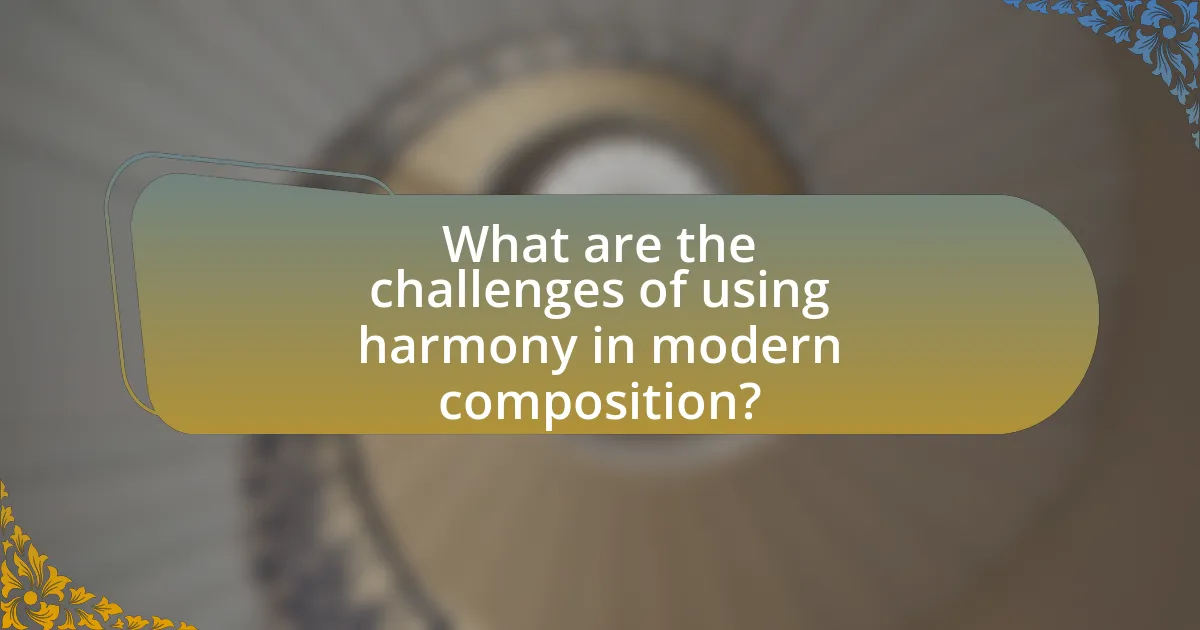
What are the challenges of using harmony in modern composition?
The challenges of using harmony in modern composition include the complexity of integrating traditional harmonic structures with contemporary styles. Modern composers often face difficulties in balancing dissonance and consonance, as well as navigating the expectations of diverse audiences. Additionally, the proliferation of digital tools can lead to over-reliance on technology, which may hinder the organic development of harmonic ideas. Historical context shows that composers like Arnold Schoenberg and Igor Stravinsky pushed harmonic boundaries, creating tension between innovation and listener accessibility. This ongoing evolution in harmony requires composers to continually adapt their techniques to maintain relevance while also honoring established traditions.
How do cultural differences impact the use of harmony?
Cultural differences significantly impact the use of harmony by shaping musical scales, chord progressions, and the emotional context of compositions. For instance, Western music often employs equal temperament tuning and major-minor tonal systems, which emphasize harmony through consonance and dissonance, while many Asian musical traditions utilize microtonal scales and different harmonic structures that prioritize modal systems. This divergence influences how harmony is perceived and utilized in compositions, as seen in the contrasting approaches of jazz, which embraces complex harmonies and improvisation, versus traditional Indian music, which focuses on raga and melodic development. Such variations highlight the role of cultural context in defining harmonic practices, demonstrating that harmony is not universally applied but rather reflects the unique aesthetic values and historical developments of each culture.
What are some common misconceptions about harmony in modern music?
Common misconceptions about harmony in modern music include the belief that harmony is solely about traditional chord progressions and that dissonance is always undesirable. Many assume that modern music lacks harmonic structure, when in fact, contemporary composers often utilize complex harmonies and unconventional progressions to create unique soundscapes. Additionally, some people think that harmony must adhere to classical rules, ignoring the fact that modern music embraces experimentation and innovation, as seen in genres like jazz and electronic music, where harmonic freedom is celebrated.
How can composers overcome the limitations of traditional harmony?
Composers can overcome the limitations of traditional harmony by incorporating non-traditional scales, extended chords, and modal interchange into their compositions. These techniques allow for greater harmonic diversity and complexity, enabling composers to explore new emotional landscapes and textures. For instance, the use of whole-tone scales or microtonality can create unique sound worlds that deviate from conventional tonal frameworks. Additionally, employing jazz-influenced harmony, such as seventh and ninth chords, can enrich the harmonic palette. Historical examples include composers like Claude Debussy and Igor Stravinsky, who utilized these methods to expand harmonic boundaries, demonstrating that innovative approaches can lead to fresh musical expressions.
What role does technology play in shaping harmony today?
Technology plays a crucial role in shaping harmony today by enabling composers to explore and manipulate harmonic structures with unprecedented ease and precision. Digital audio workstations (DAWs) and software synthesizers allow for real-time experimentation with complex chords and scales, facilitating innovative harmonic progressions that were previously difficult to achieve. For instance, tools like Ableton Live and Logic Pro provide features such as MIDI editing and chord generation, which empower musicians to create intricate harmonic textures efficiently. Additionally, advancements in artificial intelligence, such as OpenAI’s MuseNet, can analyze vast amounts of musical data to generate new harmonic ideas, further expanding the creative possibilities for composers. These technological innovations not only enhance the creative process but also democratize access to sophisticated harmonic techniques, allowing a broader range of artists to engage with and contribute to contemporary music.
How do digital tools influence harmonic choices in composition?
Digital tools significantly influence harmonic choices in composition by providing composers with advanced software that facilitates experimentation and manipulation of harmonic structures. These tools, such as digital audio workstations (DAWs) and music notation software, allow for real-time playback and instant feedback, enabling composers to explore a wider range of harmonic possibilities than traditional methods. For instance, software like Ableton Live and Logic Pro X includes features such as chord generators and harmonic analysis tools, which can suggest chord progressions and alterations based on user input. This capability not only accelerates the creative process but also encourages composers to venture beyond conventional harmonic frameworks, leading to innovative and diverse musical outcomes.
What are the implications of algorithmic composition on harmony?
Algorithmic composition significantly alters harmony by introducing new methods of generating harmonic structures that may not conform to traditional rules. This approach allows composers to explore complex harmonic relationships and unconventional chord progressions, often resulting in innovative soundscapes. For instance, algorithms can analyze vast datasets of existing music to create harmonies that blend styles or genres, leading to unique harmonic textures. Research by David Cope in “Computer Models of Musical Creativity” demonstrates how algorithmic processes can produce harmonically rich compositions that challenge conventional music theory, thereby expanding the boundaries of harmonic exploration in modern music.
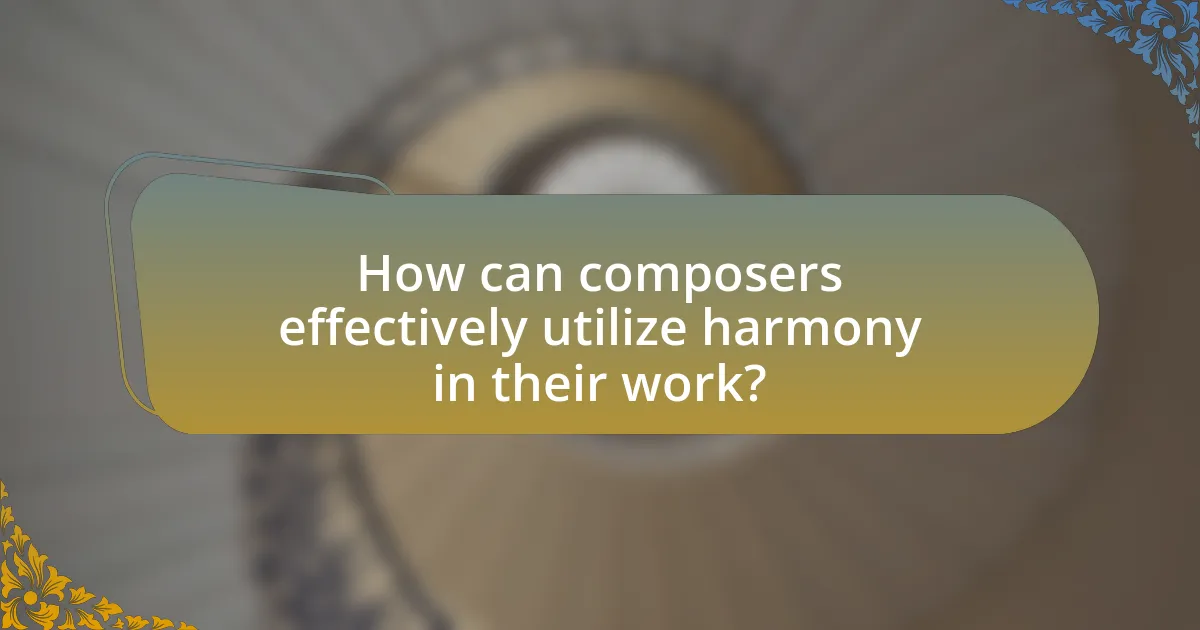
How can composers effectively utilize harmony in their work?
Composers can effectively utilize harmony by employing techniques such as chord progressions, modal interchange, and counterpoint. Chord progressions create a foundation for emotional expression, as seen in the common use of the I-IV-V-I progression in Western music, which establishes a sense of resolution. Modal interchange allows composers to borrow chords from parallel modes, enriching harmonic texture and creating unexpected emotional shifts, a technique famously used by artists like The Beatles. Counterpoint, the interplay of independent melodic lines, enhances harmonic complexity and has been a staple in compositions from the Baroque period, exemplified by Johann Sebastian Bach’s works. These methods demonstrate how harmony can be a powerful tool for composers to convey emotion and complexity in their music.
What best practices should composers follow when working with harmony?
Composers should prioritize voice leading, chord progression, and harmonic rhythm when working with harmony. Effective voice leading ensures smooth transitions between chords, which enhances the overall flow of the music. For instance, using common tones and stepwise motion can create a more cohesive sound. Additionally, understanding and applying functional harmony allows composers to create meaningful chord progressions that evoke specific emotions; for example, the use of dominant to tonic resolutions is a foundational practice in Western music. Lastly, managing harmonic rhythm—how frequently chords change—can significantly impact the piece’s energy and pacing, as seen in genres like jazz where syncopated changes create tension and release. These practices are supported by music theory principles and historical examples, demonstrating their effectiveness in composition.
How can experimentation with harmony lead to innovative compositions?
Experimentation with harmony can lead to innovative compositions by allowing composers to explore unconventional chord progressions and tonal relationships. This exploration can result in unique soundscapes that challenge traditional musical norms. For instance, composers like Claude Debussy and Igor Stravinsky utilized non-traditional harmonies to create new emotional expressions and rhythmic complexities, which significantly influenced modern music. By breaking away from established harmonic conventions, composers can discover fresh musical ideas that resonate with contemporary audiences, thus fostering innovation in composition.
What resources are available for learning about harmony in composition?
Books, online courses, and software are key resources for learning about harmony in composition. Notable books include “Tonal Harmony” by Stefan Kostka and Dorothy Payne, which provides a comprehensive overview of harmonic principles, and “The Complete Musician” by Steven G. Laitz, which integrates harmony with other musical elements. Online platforms like Coursera and Udemy offer courses specifically focused on harmony, often taught by experienced musicians and educators. Additionally, software such as MuseScore and Sibelius allows users to experiment with harmonic structures in a practical setting, reinforcing theoretical knowledge through application. These resources collectively support a thorough understanding of harmony in modern composition techniques.
What are some practical tips for incorporating harmony into modern compositions?
To incorporate harmony into modern compositions, utilize techniques such as modal interchange, extended chords, and counterpoint. Modal interchange allows composers to borrow chords from parallel modes, enriching harmonic texture and creating unexpected shifts. Extended chords, which include 7ths, 9ths, and 11ths, add depth and complexity, enhancing emotional expression. Counterpoint, the relationship between independent melodic lines, can create harmonic interest and tension, as seen in the works of contemporary composers like Steve Reich and Philip Glass. These methods not only diversify harmonic language but also align with modern musical trends, making compositions more engaging and innovative.
